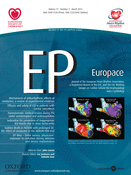-
PDF
- Split View
-
Views
-
Cite
Cite
Danilo Ricciardi, Mark La Meir, Carlo de Asmundis, Pedro Brugada, A case of in vivo thrombogenicity of an externalized Riata ST lead, EP Europace, Volume 15, Issue 3, March 2013, Page 428, https://doi.org/10.1093/europace/eus395
Close - Share Icon Share
A 67-year-old man who had undergone implantation of a dual-chamber implantable cardioverter defibrillator (ICD) with a Riata lead, model #7020 (St Jude Medical) in 2007, 3 months ago presented with deterioration of heart failure. Interrogation of the ICD showed an R-wave sensing of 7.8 mV, a ventricular pacing threshold of 1.0 V at 0.5 ms, pacing lead impedance 830 Ω, high-voltage lead impedance 48 Ω, the memory of the device did not show any arrhythmic episode. When viewed during coronary angiography (panel A), the ICD lead showed insulation damage with externalization of the inner cables (arrows). The patient underwent a coronary artery bypass surgery and the defective lead was also surgically removed at that time. At the opening of the right atrium the lead showed a longitudinal thrombus measuring 3.5 and 1.5 cm in maximal width around the segment of the insulation failure, together with a strong fibrotic tissue surrounding the lead attached to the tricuspid valve (panel B). This case is a demonstration that the Riata Leads tendency to insulation damage can be prone to formation of thrombi, which may have a clinical significance, even not having a technical failure of the lead.
Conflict of interest: none declared.



